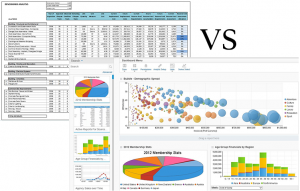Printed Reports R.I.P. = Resist Impulse to Print
All businesses rely on reports to tell them how they’re doing. However, if your business has a unified single database you don’t need as many printed reports as you might think. You have access to the power of “Live Data”. Live Data is real-time information that is relevant, has context with  other decision making information and comes from a trusted source. Resist the impulse to print before you ask for a report.
other decision making information and comes from a trusted source. Resist the impulse to print before you ask for a report.
In over two decades of implementing software, during the process of a customer learning our system, we inevitably are asked for a list of the “Reports” we provide. Quite often gaps are identified in the process; a manager absolutely needs this key report or they can’t do their job. Most of the time this is typically a spreadsheet that compiles information from one data source to another. Great amounts of effort can go into making and keeping this spreadsheet up-to-date and distributing printed copies for other stakeholders.
There is no doubt the information in that report is key to performing their job, but it does warrant a discussion about how the report is used; what are all the inputs, what calculations take place and ultimately what is the output and how is it interpreted and used by the reader. After going through this exercise, in just about every case the result can be achieved with a real-time query against a single database that holds all the information about the business. So the user gets the information they need, they get it on demand, in context and with data integrity. This process can eliminate more than half the “critical” management printed reports required in a business.
Now don’t get me wrong, we have many reports that are formatted and can and should be printed, but in most cases the concept of “Live Data” is a game changer.
Some simple criteria can be used to determine if a printed report or accessing live data is the correct answer:
- Once a report is printed it can’t change or update itself. So does the information on that report change often? Does it change drastically from one hour or day to another? Would that changed information alter the decision being made based upon that report?
- Is the printed report stating information for a closed accounting period? If not it is likely obsolete once it hits the printed page.
- Do users often want to know what is behind the numbers. A printed report is static, there is no drill down and no ability to research where those numbers came from.
- Sometimes we need to rearrange information on a report to make more sense of it. Sorting and Filtering must be done before you run a printed report, and many reports don’t give you a full list of columns to sort and filter. If manipulation of the output of a report is desirable a printed report can be very limiting.
We believe in “Live Data”. Live Data is an interactive screen that allows columns to be sorted, data to be filtered, and allows drill down into the data behind the information. Live Data views are connected directly to the database, and reflect “real time” information within the context of other information.
There is still a place for printed reports; nicely formatted quotes, proposals, invoices, purchase orders, etc., but there is a growing need to access Live Data. So the next time someone requests a report, ask “Is it printed, or is it live?” Printed Reports – R.I.P., long live Live Data!

